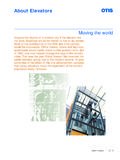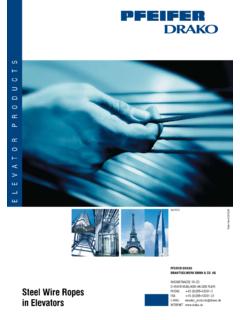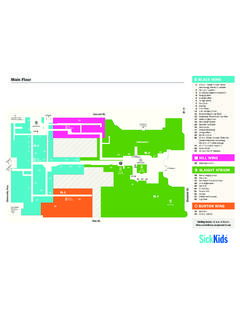Transcription of Deadline Approaches for 40,000 NYC Elevators - GAL
1 50 September 2017 The statistics pertaining to Elevators can be eye-opening. For instance, according to , Elevators make 18 billion trips a year.[1] As for safety, the Bureau of Labor Statistics and the Consumer Product Safety Commission report that, on average, 27 people die, and 10,200 are injured every year nationwide in elevator accidents.[1] And, according to the Labor Department Census of Fatal Occupational Injuries, a little over half of the deaths occur during the repair, service or maintenance of elevator equipment, or affect people who use Elevators as part of their daily employment (such as office workers).[1]For those with a penchant for percentages, an article by the Los Angeles Times estimated the elevator fatality rate to be per trip.
2 [3] This is a miniscule percentage, especially when you consider that automobile crashes claim 27 victims every 6-7 hours in the [4]It s not hard to imagine how one could be lulled into a sense of complacency, into thinking that the modern elevator is hardly in need of any modification or improvement. After all, there is a measure of risk, which some might call acceptable risk, that a person takes just getting out of bed or crossing the , for professionals in the elevator industry, even a small percentage of failure, for any reason, is unacceptable. They understand that even the smallest error can create tragic results. They understand that with today s 24/7 news cycle and social-media-driven reality, we live in a world where legions of personal-injury lawyers are constantly on the lookout for any elevator bodies and foresighted industry professionals have sought to add various features to the elevator to provide greater passenger safety.
3 Unfortunately, as is often the case with Deadline Approaches for 40,000 NYC Elevators Devices like GAL FM1 can put units into compliance with new codeCodes and Standardsby Peter Novak and Steven OrtThe GAL FM1 system uses a microprocessor on its circuit board to detect door September 2017complicated devices, system improvement is also driven by tragic accidents. It was one such tragedy that led to a recent change in the New York City (NYC) Department of Buildings (DOB) Building Code, which must be addressed by January 1, 2020, for Elevators to be in compliance. This code change has enormous implications; in fact, the provision impacts up to 40,000 Elevators out of the 65,000 throughout the city.
4 It addresses a safety issue that most of the public believes is implicit: that an elevator car will never move with its doors open. Unfortunately, that doesn t always prove Tragedy Spurs a ChangeMany NYC industry professionals may still recall an incident from December 2011 where a young office worker was killed when the elevator doors at her workplace malfunctioned. Unfortunately, this was not the first instance where either a faulty car door mechanism, poor wiring technique or maintenance worker using a wire jumper a practice service mechanics often use to bypass elevator safety mechanisms resulted in a serious accident. The severity of this accident and its occurrence in such a prominent venue, however, were enough to grab headlines and make immediate action imperative.
5 So, even as experts reviewed the circumstances behind the accident, the NYC DOB elevator Code Committee moved quickly, lobbying the city council to adopt an addition to the building addition, Appendix K3, Rule , says that means shall be provided to monitor the hall doors and car gate for faulty circuits, and, if a faulty circuit is detected, the elevator shall be prevented from operating and removed from service. This rule applies to all passenger and freight Elevators under the jurisdiction of the NYC DOB and sets the Deadline for compliance at January 1, s FMG1, working in conjunction with a Hollister-Whitney Rope Gripper , can prevent unintentional car movement and ascending car overspeed motion.
6 ELEVATE YOUR BUSINESS WITH OUR FAMILY OF COMPANIES An innovator of residential Elevators , residential & commercial dumbwaiters. Manufacturer and distributer of elevator and escalator parts and accessories. A service leader for distributing elevator & electrical components. With warehouses in CA, IL, and WI. 800-266-8654 800-222-3688 800-238-8739 NAEC National Association of elevator Contractors Booth # 1301 Visit us Sept 13 - 14, 2017, booth # 1301 NAEC Annual Convention, Orlando, Florida Continued54 September 2017 While the new rule is based on ASME , Section , System to Monitor and Prevent Automatic Operation of the elevator With Faulty Door Contact Circuits, its firm Deadline for compliance gave the measure real teeth.
7 Also, the fact that this provision would apply retroactively to all NYC Elevators made this case unique throughout the industry. Certainly, many of NYC s newer elevator systems already feature controllers with the capability to monitor elevator door faults and prevent potential accidents, and have been installed for years. But, this code change could impact up to 40,000 Elevators and affect tens of millions of passenger trips a d ay.[5] So, the question for many was not whether the rule change was a good idea, but if it could be fully implemented in the time allowed and how much it would Solutions at HandToday, many companies offer door and gate fault-monitoring mechanisms as add-on features, but whether that option comes installed on a controller often depends on geography.
8 As is often the case, if an AHJ does not specify such a feature in its elevator code, it is often left out. Making the situation more difficult, even if a professional were looking to employ a door and gate fault-monitoring system, it can sometimes be difficult to determine whether a particular controller provides the feature. Though some manufacturers do call attention to it in their sales literature, others mention it only in passing, if at monitoring, which is sometimes referred to as redundancy, has been included in code since 2000 and is in controls built to meet 2000 or subsequent codes. This means that most microprocessor-based controllers built since 2000 (and a few relay-based systems built earlier) either come with monitor circuitry already installed or can be connected to devices that have door fault-monitoring capability.
9 The problem NYC professionals face comes from the vast number of Elevators in the city using legacy equipment, which will not easily permit fault monitoring to be added. Elevators are typically required to meet only the code requirements in effect in the year they were installed. The fact that this code change would be enforced retroactively was almost without precedent in the 40 years ago, GAL Manufacturing Corp. developed technology that provides the ability to detect a jumped or faulty This code change has enormous implications; in fact, the provision impacts up to 40,000 Elevators out of the 65,000 throughout the city. It addresses a safety issue that most of the public believes is implicit: that an elevator car will never move with its doors open.
10 Unfortunately, that doesn t always prove LADDER POWEREDRETRACTA LADDER 2 3/4 clear retracted, 7" rung-to-wall extended NEMA 4X (IP67) electrical device auto opens safety circuit B44 compliant Improve safety, reduce liability Larger elevator , smaller shaft Patented Made in the USA Solves 39" max. ladder-to-door lock release problem Also use in overhead for machine access on MRLs Don't reach unsafe distance to the ladder, typ. +21/2 feet Ladder comes to you with the turn of a key 6 1/4" clear retracted, 36" rung-to-wall extended UL Labled 1000 Ibf actuator & IP67 electrical device B44 compliantRetractable pit & overhead access ladders to fit tight spaces where other ladders won'tSafer pit / overhead access where the reach is too far(415) Day Shipping!









